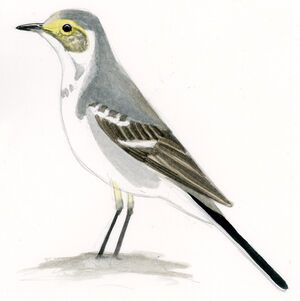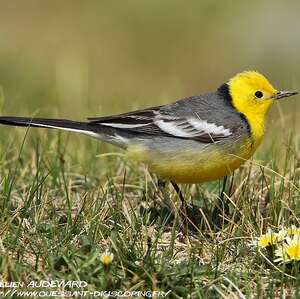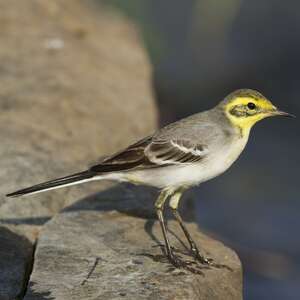Citrine Wagtail
Motacilla citreola - Bergeronnette citrine
Identification
The species is polytypic and only the nominal race M. c. citreola is present in Europe. However, European populations are often divided into two subspecies: M. c. citreola which nests in the northern part of the species' range, and M. c. werae which nests further south.
The breeding male of the Citrine Wagtail has a canary yellow head and neck. The back is a blue-grey with a black nape. The breast is yellow and the undertail usually white. The tail is black with the outer rectrices being white. It has a double wing bar, pale and quite wide. The female and non-breeding males are less contrasting. Their tail is longer than that of the Spring Wagtail, allowing them to be distinguished. The crown and parietal coverts are greyish and note the absence of black at the nape. The cheeks are surrounded by yellow and the breast is shaded with grey. In first-winter individuals the pure yellow has disappeared and only faint yellow tones appear on the forehead and chest. The parotids are surrounded by pale. It can easily be confused with a juvenile of the Spring Wagtail.
Subspecific information 2 subspecies
- Motacilla citreola citreola (n, e Europe to c Siberia, Mongolia and ne China)
- Motacilla citreola calcarata (e Iran and Afghanistan to c China)
Foreign names
- Bergeronnette citrine,
- Lavandera cetrina,
- alvéola-citrina,
- Zitronenstelze,
- citrombillegető,
- Citroenkwikstaart,
- Cutrettola testagialla orientale,
- citronärla,
- Sitronerle,
- trasochvost žltohlavý,
- konipas citronový,
- Citronvipstjert,
- sitruunavästäräkki,
- Sitrienkwikkie,
- cuereta citrina,
- Mýrerla,
- pliszka cytrynowa,
- citroncielava,
- citronasta pastirica,
- Желтоголовая трясогузка,
- キガシラセキレイ,
- 黄头鹡鸰,
- นกเด้าลมหัวเหลือง,
- 黃頭鶺鴒,
Voice song and call
Its contact call, a high-pitched sriip, is very similar to that of the Spring Wagtail but more drawn-out, whereas its song is very comparable to that of the Grey Wagtail.
Habitat
Behaviour character trait
The Citrine Wagtail is a migratory bird. It winters in Southeast Asia and India. It is gregarious during the winter and can be found in small groups or large flocks in association with other wagtails. It does not stray far from wet areas. It can also be found on water bodies exploring partially submerged vegetation in search of insects. It can be seen pursuing an insect that has escaped it. The nest of the Citrine Wagtail is sometimes parasitized by a cuckoo (Cuculus canorus).
Reproduction nesting
The Citrine Wagtail nests on the ground in a hollow hidden by tufts of grass, shrubs and sometimes even under a stone.
The nest is a cup made from dry grass, moss and roots. Its interior is lined with fur and wool. Reproduction takes place between May and July. The female lays between three and five eggs, smooth and glossy, fawn or light grey, finely speckled with grey or light brown, sometimes dark brown. Most often it is four eggs that she will lay and which will be incubated for 14 to 15 days. Both parents participate in the incubation and the raising of the young.Threats - protection
Sources of information
- IOC World Bird List (v15.1), Gill, F and D Donsker (Eds). 2025-12-07.
Other sources of interest
 Specification sheet created on
03/08/2023 by Jean-Pierre Trouillas
Specification sheet created on
03/08/2023 by Jean-Pierre TrouillasTranslation by AI Oiseaux.net
© 1996-2026 Oiseaux.net
- Accipitriformes
- Aegotheliformes
- Anseriformes
- Apodiformes
- Apterygiformes
- Bucerotiformes
- Caprimulgiformes
- Cariamiformes
- Casuariiformes
- Charadriiformes
- Ciconiiformes
- Coliiformes
- Columbiformes
- Coraciiformes
- Cuculiformes
- Eurypygiformes
- Falconiformes
- Galliformes
- Gaviiformes
- Gruiformes
- Leptosomiformes
- Mesitornithiformes
- Musophagiformes
- Nyctibiiformes
- Opisthocomiformes
- Otidiformes
- Passeriformes
- Pelecaniformes
- Phaethontiformes
- Phoenicopteriformes
- Piciformes
- Podargiformes
- Podicipediformes
- Procellariiformes
- Psittaciformes
- Pterocliformes
- Rheiformes
- Sphenisciformes
- Steatornithiformes
- Strigiformes
- Struthioniformes
- Suliformes
- Tinamiformes
- Trogoniformes





























